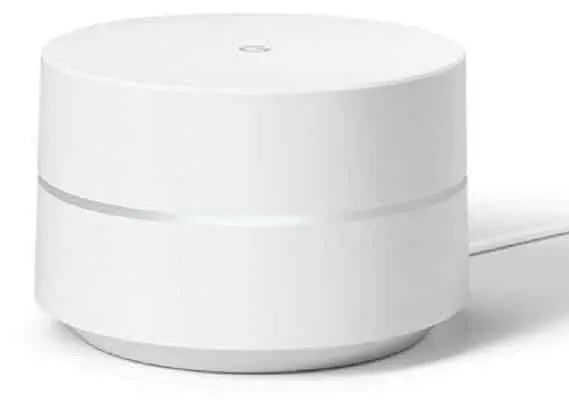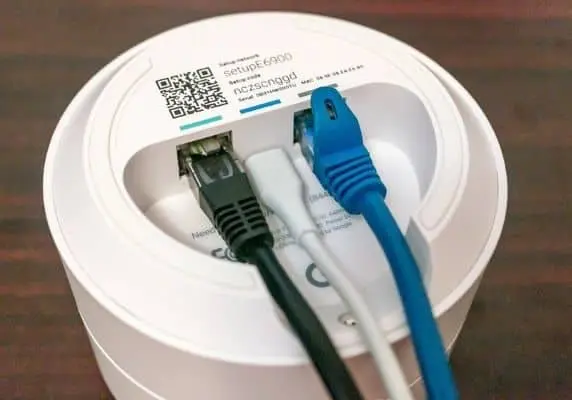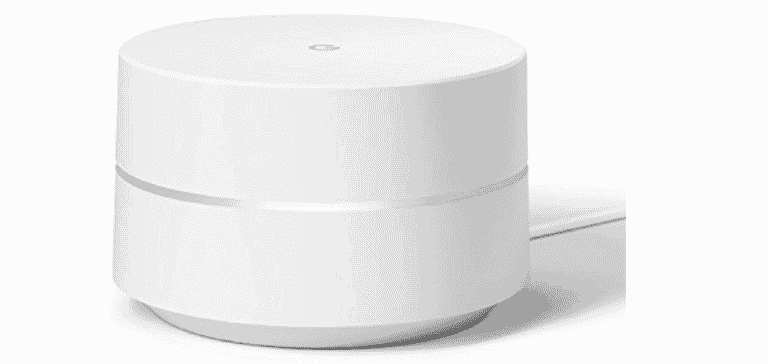Google Wifi is an affordable and easy to use Wifi available in the market currently. If you are still not sure if you should get yourself Google Wifi router, then here is a review of Google Wifi for you.
What you will see?
Google Wifi
Other mesh Wi-Fi systems may have come out ahead of Google Wifi, but no other mesh router has done as much to introduce mesh routers to the mainstream as this Google entry has. In essence, Google Wifi has established the standard for what a mesh Wi-Fi router should be. That’s because the Google mesh router combines a pared-down design, a simple setup, and a comprehensive feature set at an affordable price. It also fits in nicely wherever you put it and ensures a reliable, constant connection regardless of where you are in your service area. Whether you have a weak and irregular internet signal or are ready to upgrade from a traditional router configuration, Google Wifi is an excellent choice.
Its performance, functionality, and, of course, pricing make it just the right thing to choose. Moreover, with this, you can forget about using an extender to fill in Wi-Fi dead zones. Google’s Wifi mesh-router kit is a simple, quick, and reasonably inexpensive way to cover a home with wireless data.
Pros
- Easy setup
- Great value
- Excellent design
- Amazing user interface
- Stable, consistent signals
- Small, unobtrusive design
- Works with Philips Hue smart lights, IFTTT
- Trusted Platform Module to verify firmware
Cons
- Limited hardware control
- Lower AC rating
- Short-range for single unit
- No parental controls
- Lacks USB ports
| Wireless Connectivity | IEEE 802.11a/b/g/n/ac, AC1200 2×2 Wave 2 Wi-Fi (expandable mesh, dual-band 2.4GHz and 5GHz, TX beamforming), Bluetooth Smart ready |
| Processor | Quad-core ARM CPU (each core up to 710MHz) |
| Memory | 512MB RAM |
| Storage | 4GB eMMC flash |
| Beamforming | Implicit and Explicit for 2.4 & 5GHz bands |
| Ports | 2 x Gigabit Ethernet ports per Wifi point (1 WAN and 1 LAN port each) |
| Dimensions | 4.1 x 2.7 inches each |
| Weight | 12oz each |
| Number of Antennas/Removable | 4/No |
| Ports | Two 1Gbps LAN, USB-C (power) |
| WiFi Chip | Qualcomm IPQ4019 |
Price and Availability
Google isn’t asking for much in terms of accessibility and functionalities, especially considering what Google Wifi can achieve. The first generation Wifi includes one primary “Wi-Fi point” and two secondary Wi-Fi points. Three Wi-Fi Points, according to Google, may cover up to 4,500 square feet in an area. The new generation of Google Wifi devices shaves $60 off the price of the three-pack setup. A single Google Wifi unit can be purchased for $99. If you’re working with a small flat, it’ll provide plenty of coverage at an unbelievable price. If you’re in the UK, you can get the Google Wifi in a 2-pack or a 3-pack. The Google Wifi is an incredible deal, offering more units for less money than any of its competitors, with other wireless mesh routers costing at least $400 for the same amount of mesh nodes.
Design

Google is not only affordable, but it also has the most aesthetically pleasing Wi-Fi equipment and possibly the simplest configuration. Each device, a little cylinder with a white LED band in the center, has the same functionality. This means that any Google Wifi unit can operate as the system’s main ‘router’. Whereas, the others can use their Ethernet connections and wireless internet to expand the wired signal supplied to the unit wirelessly. USB-C is used to power all three units. Each unit is small, measuring 4.1 inches in diameter and 2.7 inches in height, and you can put it on a shelf or a window sill. Each piece of equipment has an LED ring that displays its status. You can turn off or mute the LED ring. When things are working alright, it lights bluish-white, but when your internet connection is lost, it becomes amber.
The Google Wifi does not have a touch screen, or the ability to function as a clock and visual network monitor. It has a maximum capacity of 1.2Gbps and is based on 2×2 MIMO technology. This means it can manage two streams of simultaneous data connections with one suitably equipped laptop. A total of five antennas (four Wi-Fi and one Bluetooth) are positioned around the circumference. Each node has a coverage area of 1,500 square feet. In theory, three it can cover a 4,500-square-foot home. To cover more ground, you can connect up to four satellites, giving you a total of five broadcast locations.
The USB-C power port and 2Gb Ethernet connections are on the underside of each unit for connecting the router to the internet modem. There is also a networked data storage unit, printer, or LAN switch. To utilize Google Wifi, you’ll need to disable the router functions on your combo router.
Setup

Google Wifi setup is quite easy, thanks to a free iOS or Android app that makes the procedure go as smoothly as its hardware design. No prior understanding of networking, the internet, or computer technology is required. You will, however, require a Google account. After you sign in with your Google account, the app locates your device and prompts you to select or put its position. The Google Wifi app will let you set up your network by scanning the QR codes on the Wi-Fi point connected to your modem or gateway. You can then name your new network and create a password in the app. Also, if you want to use any additional Wi-Fi points, you will have to scan their QR codes. After that, you will be able to name individual nodes in the app.
Google WiFi App
It simply takes a brief time for the first Google Wifi node to recognize additional nodes and for them to begin communicating with each other. The interface establishes a Bluetooth connection with your phone or tablet in a matter of seconds. Band switching isn’t an option because you won’t have the same level of access that Netgear Orbi does. Google Wifi, on the other hand, takes care of this for you behind the curtains. More useful settings are available in the Google Wifi app, such as continuous monitoring of your network and the points and devices connecting to it. It also includes an internet speed test that analyses the health of your Points’ connections. Moreover, it has a Wi-Fi test that measures the strength of your connection from within the network.
Despite the lack of dropdown boxes and toggles, this is the most comprehensive and sophisticated set of controls seen on a Wi-Fi mesh system. You can also use this software to prioritize bandwidth to one device at a time, control smart home devices, and pause internet access to select devices in a family setting. Google Wifi’s Network Check functionality to test multiple devices, allows you to identify potential network bottlenecks and rearrange your Google Wifi access points to improve network performance. There are apps for iOS 8 and later, as well as Android 4 and later. However, there is no ability to configure the devices from a PC, Mac, or internet interface, as there is with most mesh-router systems.
Performance
Google Wifi can rival, if not outperform, other WiFi systems in terms of performance. It gives you the most out of your 100Mbps Wi-Fi service like this one. The main difference is that Google Wifi is capable of delivering this level of performance to every room of your home. You can watch a 4K video on Netflix in your room and play games in the office without any issues. Wi-Fi mesh systems, such as the Google Wifi, are more concerned with coverage than with throughput. Nonetheless, this product performs admirably.
The traffic priority tool ensures that your gaming session receives more crucial bandwidth than other devices in your home that are commonly used for browsing and streaming HD videos. Moreover, if one or more of the Wi-Fi Points loses power, the network can automatically repair itself. The stunning price-to-coverage ratio of Google Wifi sets it apart from competing routers. Furthermore, the flexibility gained by having more units in terms of eliminating dead areas is enormous. Each Wifi device is equipped with a quad-core ARM processor running at 710 MHz, 512MB of RAM, and 4GB of solid-state storage.
Qualcomm’s IPQ4019 Wi-Fi radio and control chip is used. According to Google, an internal network made up of three or more nodes is a genuine mesh network. This is because each node is equal and signals can be sent between satellite nodes without passing via the router node.
Warranty and Support
The Google Wifi mesh kit comes with a one-year guarantee and access to a wealth of online resources. This includes videos, tips, and mesh tutorials. If you need to contact a technician, there is a 24-hour hotline available. Furthermore, you can also send them an email. However, on the negative side, there is no instruction manual.
Customization and Smart Home
The Google Wifi app’s setup screens are in portrait mode. The main panel monitors the network, displays whether your extensions are connected, and allows you to change the parameters of a guest network. A network check can be performed at any time. The Settings section allows you to prioritize which systems get data first. Moreover, you can even use IFTTT to operate home automation devices like the Philips Hue bridge and linked lights, smart thermostats, and smart locks. However, unlike other mesh-router systems, which can take basic
Although Google shares a parent company with Nest Labs, IFTTT is at the moment the only way Google Wifi can connect with the Nest Cam, Protect, and Smart Thermostat. You can handle port forwarding and set your preferred DNS server with the app. However, when compared to certain typical routers, the Network Settings are limited. It only includes the ability to restart the router, perform a factory reset, and add another extension. Static IP addresses are supported and you may even reserve IP addresses for critical LAN accessories. It also lacks features like the ability to vary the channel width and adjust the transmission strength. While currently, Google Wifi does not support IP version 6 addressing, the company is working on a software upgrade that will.
Security and Parental Controls
Google Wifi, like other modern mesh-router systems, provides WPA2 wireless encryption. However, it will not function with older, less secure WEP-based devices. If you have any Wi-Fi-enabled devices that were manufactured prior to 2002, you may need to connect them to the router via Ethernet. An Infineon Trusted Platform Module (TPM) is incorporated into every Google Wifi device. It stops the hackers by forming an encrypted link with Google’s servers for downloads and checking the loaded firmware upon reboot. The device upgrades its software automatically as needed, something that many mesh routers and traditional routers are starting to do.
Although, Google Wifi lacks parental controls. For certain events, you can “pause” the internet connection to select or all devices. However, it is just the limit. Blacklisting websites or categories won’t stop you from venturing into the dark side of the internet. Moreover, you can’t even set a limit on how long each user can spend online. Also, Google Wifi does not screen out known harmful websites.
Conclusion-The Final Review
The Google Wifi is the easiest and most straightforward router available on the market. That’s not even taking into account the two more devices required to complete the process. Google carefully considered every toggle and test it could present through its app in a readily understood manner. Moreover, you also get the option to set bandwidth priority. Not only this, it has a simple, uncomplicated hardware design that’s easier to display in plain sight. Although it isn’t the most powerful mesh-router kit on the market, the three-pack Wi-Fi is one of the most affordable and straightforward methods to equip a large home with reliable wifi connections. Google Wifi may not be for everyone because it lacks parental controls, a complex settings menu, and a desktop administration interface. But it is for those who want to set up a mesh-router system without spending too much time or money on it.
If you have any questions, you can ask in the comments section below.
















